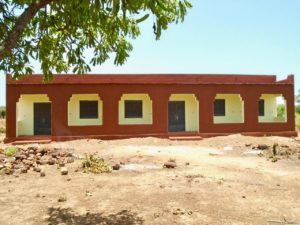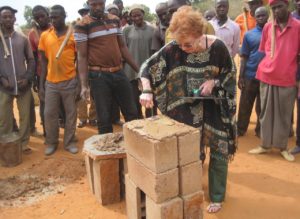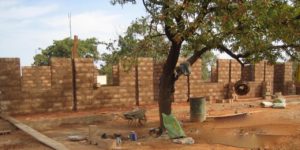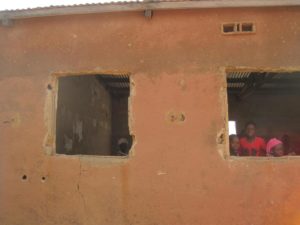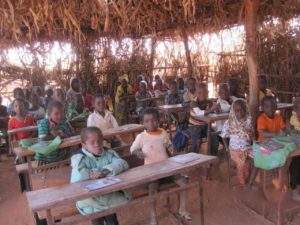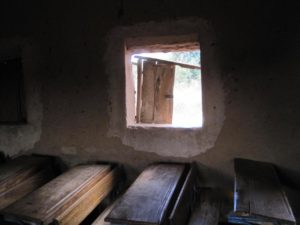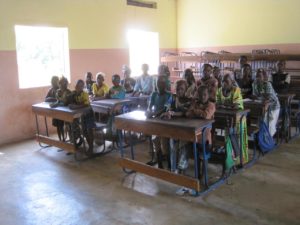This was an exceptional year for this tiny non-profit organization. Our 17th school was completed in Doumanaba last spring, providing new classrooms to replace classes that had been housed in an old storeroom, and two more schools are presently under construction.
Our 18th project was to build a new school in the community of Kodialanida; the roof of one of their classrooms had collapsed earlier in the year, injuring several children. We were exceptionally fortunate to be contacted by a generous family in the American west; they not only donated funds for THREE classrooms, but also added solar panels for one classrooms, giving children and teachers the ability to do homework or plan lessons after dark, and provide evening literacy classes or hold meetings.
In November, BSA Director Judy Lorimer traveled to Mali (at her own expense) to participate in the groundbreaking ceremonies for Kodialanida and also Nolabougou, where we planned to build two new classrooms.
In 16 days, the walls of Kodialanida’s new school were up to the tops of the windows.
In Nolabougou, they had three cement block classrooms that had been built 20 years ago and were showing their age – crumbling cement around rusted or missing doors and windows, cracked walls, and broken concrete floors. Since Save the Children had recently built new latrines and the office/storage building that BSA usually builds, we will be able to use those funds to repair and paint the old classrooms as well as replacing temporary or mud- brick classrooms with brand new ones, thanks in large part to a substantial donation from Wigigo.
We visited four schools that we have built since 2011: Sossoro, Kounfouna, Tiogola and Doumanaba. The donor for Kodialanida also designed a survey that we gave to the ten most recent schools, to determine how having the new schools has impacted life in their communities. The survey will help us determine future expansions and track the growth in the number of children attending school. We hope to publish the survey results on our website after the information is compiled. Most of the communities where we have built new schools have reported increased enrollments, and they would like more classrooms. Visits to other communities on our waiting list reveal that there are still far too many villages that are making do with temporary shelters: walls of straw mats or cornstalks lashed to wooden poles, or the small, dark and stuffy buildings made of mud brick.
N’Dalen, our next project, is fortunate to be a large village that draws students from nearby communities to its middle school, which has an enrollment of 400+, but they need more concrete classrooms for their grades 1-3, now housed in mud-brick or temporary classrooms. As you can imagine, it is much easier to hire and keep teachers if they have decent, light and airy classrooms in which to teach.
All our classrooms meet or exceed government standards, with 5 large windows in each classroom. Contrast the photo below with the one in Tabakoro: the mud-brick walls have large cracks, and the doors and windows are in disrepair. But we also have a request for a new middle school in the large town of M’Pessoba. Middle schools are rare outside the major cities, which means that for most children in rural areas, their education effectively ends with grade 6, unless there is a middle school within walking distance or parents can afford to board their children with friends or relatives in a town that does offer grades 7 through 9. High schools are usually found only in the major towns and cities.
There is no end to the demand – and need – for more schools, and our waiting list keeps growing. The two schools presently under construction should be completed by the end of February, and depending on available funding, we will start construction in N’Dalen by next fall.
Build a School in Africa is a very small organization, but we have managed to raise funds for 19 schools since 2005; N’Dalen will be our 20th. A popular Malian proverb states “Dooni dooni kononi be nyaga da” — “Little by little the bird builds its nest.” Every donation helps, and we thank all our supporters for their generosity.
I ni ce — Thank you! Best wishes for a joyous and healthy year in 2018.
Judy Lorimer, Madou Traore, Abou Coulibaly, and Matt Heberger

